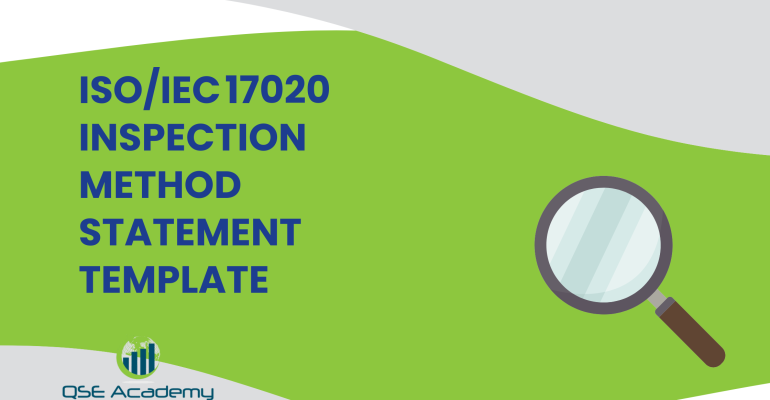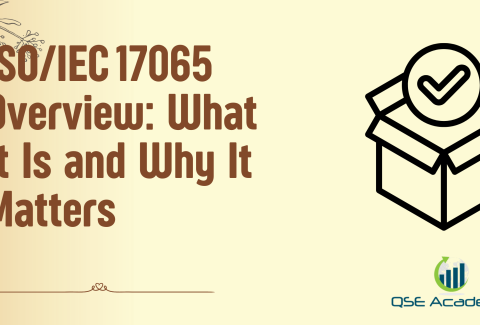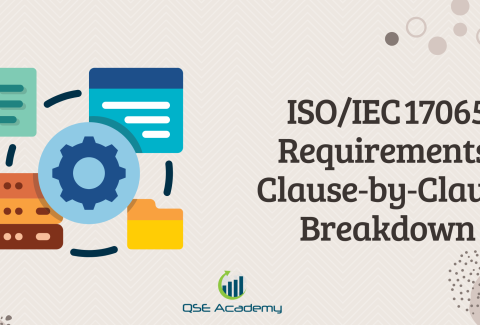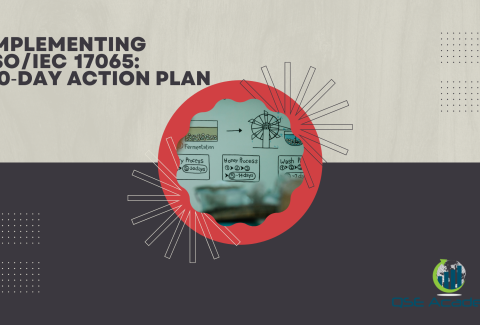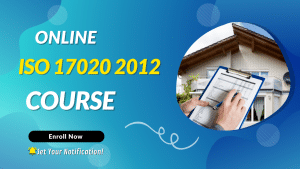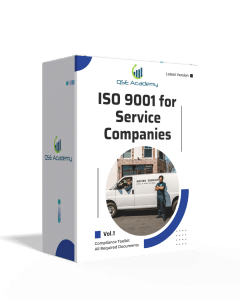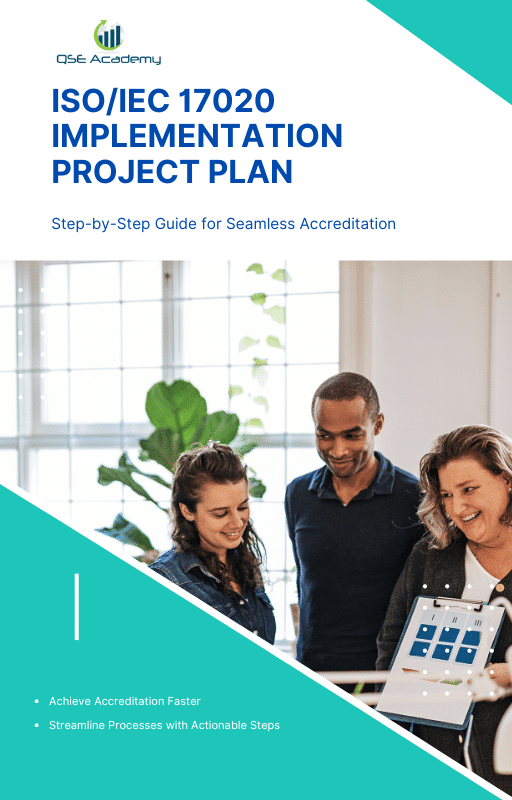ISO/IEC 17020 Inspection Method Statement
Last Updated on October 22, 2025 by Hafsa J.
Understanding the ISO/IEC 17020 Inspection Method Statement
Let’s be honest—most inspection bodies I’ve worked with are excellent at carrying out inspections but struggle to document how they do it in a consistent, standardized way. They might say, “Our inspectors already know the process,” and that’s true—until the assessor asks, “Can you show me your approved inspection method statement?”
That’s usually when the silence starts.
In my experience, the Inspection Method Statement is one of the most misunderstood parts of ISO/IEC 17020. It’s not just a checklist or a set of technical steps—it’s your proof of consistency. It tells the accreditation body, “Every inspector in our organization follows the same validated method, producing results that are reliable, impartial, and repeatable.”
Here’s what I’ve noticed: when inspection bodies skip this step, their processes rely too heavily on individual experience. That might work for a while, but it introduces risk—what happens when a senior inspector leaves or a new one joins? Without a documented method statement, you lose control over how inspections are performed and evaluated.
A well-written ISO/IEC 17020 Inspection Method Statement eliminates that risk. It defines your inspection scope, lists your tools, describes each step, and clarifies how results are judged. More importantly, it makes your process auditable, traceable, and defensible during accreditation.
In this guide, I’ll walk you through exactly what an inspection method statement is, how ISO/IEC 17020 defines it, and how to create one that’s both technically sound and audit-ready. Whether you’re just building your system or fine-tuning an existing one, you’ll learn how to document your inspection process so well that assessors immediately see your competence and control.
Now that we’ve set the stage, let’s unpack what the ISO/IEC 17020 standard actually requires when it comes to inspection methods—and why those requirements form the backbone of your entire management system.
ISO/IEC 17020 Requirements for Inspection Methods
Here’s what I’ve noticed over the years—most nonconformities related to inspection methods happen not because the work isn’t done correctly, but because it isn’t documented or controlled according to ISO/IEC 17020 requirements. Inspectors may be following the right steps intuitively, but if those steps aren’t validated, written, and traceable, assessors will flag it as a system weakness.
Let’s break down what the standard really expects from you.
1. Where ISO/IEC 17020 Mentions Inspection Methods
The key clauses to focus on are:
-
Clause 6.1 — Inspection Methods and Procedures
Requires you to establish and maintain documented methods appropriate for your inspection activities. These methods must be up-to-date, validated, and technically sound. -
Clause 6.2 — Equipment and Tools
States that any instruments or tools used in inspections must be suitable, calibrated where applicable, and used according to your documented method. -
Clause 7.1 — Inspection Process Control
Emphasizes that every inspection should follow an approved method from planning to reporting. Any deviation must be justified, recorded, and authorized.
In short: ISO/IEC 17020 doesn’t just ask you to inspect—it asks you to prove how you inspect, why you inspect that way, and who approved that method.
2. Inspection Method vs. Procedure vs. Work Instruction
These three terms often confuse teams, so let’s clear that up:
| Term | Purpose | Level of Detail |
|---|---|---|
| Inspection Method | Defines what and how an inspection is carried out (sequence, acceptance criteria, tools). | High-level technical overview. |
| Inspection Procedure | Describes the management controls around inspections (authorization, planning, record keeping). | System-level. |
| Work Instruction | Gives detailed step-by-step directions for inspectors performing the task. | Task-specific. |
Pro Tip: Think of your method statement as the bridge between your management system and on-site inspection work—it ties policy and practice together.
3. Validation and Control of Methods
Every inspection method—whether adopted from an international standard, a client specification, or developed in-house—must be validated before use. That means confirming that it delivers reliable, consistent results under your actual working conditions.
Validation can include:
-
Comparison against a reference method or standard.
-
Replication tests to confirm repeatability.
-
Technical review by a qualified expert.
Once validated, the method must be approved, version-controlled, and periodically reviewed.
Common Pitfall: Many organizations use “customer-provided methods” without verifying their adequacy. Remember—under ISO/IEC 17020, you are responsible for the suitability and control of every method you apply, even if it came from the client.
4. Why This Matters
Documented and validated inspection methods aren’t just for the assessor—they protect your credibility. They ensure that no matter who performs the inspection, the outcome remains technically defensible and aligned with both client and regulatory requirements.
Now that you know exactly what ISO/IEC 17020 expects, let’s look at how to structure your Inspection Method Statement so it’s clear, complete, and ready for accreditation.
Structure and Key Elements of an ISO/IEC 17020 Inspection Method Statement
Here’s what I’ve seen time and again: the difference between a strong inspection body and a weak one isn’t how much experience the inspectors have—it’s how clearly their inspection methods are defined and controlled. A solid Inspection Method Statement gives your entire team one reliable playbook to follow. It standardizes how inspections are performed, recorded, and judged, leaving no room for guesswork.
Let’s look at what a well-structured ISO/IEC 17020 Inspection Method Statement should contain and why each element matters.
1. The Core Sections You Must Include
| Section Title | Purpose / Description | Linked ISO/IEC 17020 Clause |
|---|---|---|
| Scope | Defines what is being inspected (product, system, site, equipment) and the limits of inspection responsibility. | 6.1 |
| References | Lists applicable standards, codes, manufacturer specifications, or client requirements. | 6.1.3 |
| Equipment and Materials | Identifies instruments, tools, and materials required, with calibration and maintenance references. | 6.2 |
| Personnel Competence | Specifies who is qualified to perform the inspection and under what authorization level. | 5.2 |
| Inspection Method / Steps | Describes the sequence of activities—from preparation to reporting—ensuring repeatability. | 7.1 |
| Acceptance Criteria | Defines clear pass/fail or compliance thresholds; removes subjective judgment. | 7.1.3 |
| Records and Reports | Lists required forms, data sheets, or software used to capture results. | 7.4 |
| Safety and Environmental Controls | Highlights hazards, PPE requirements, and any environmental considerations. | 6.1.4 |
| Approval and Revision Control | Indicates who approved the method and how revisions are tracked. | 8.3 |
2. Keep the Format Simple and Visual
A good inspection method statement reads like a field guide, not a policy document. Use:
-
Tables and bullet points instead of long paragraphs.
-
Flowcharts to show inspection sequence.
-
Photos or diagrams for equipment setup, when applicable.
Pro Tip: If your inspectors carry tablets or laptops, design your method statements in a fillable PDF format—auditors appreciate seeing digital control and traceable completion logs.
3. Tailor the Content to Each Inspection Type
Don’t try to make one generic document fit all. Each inspection category—electrical, mechanical, environmental, construction—deserves its own method statement with relevant standards and acceptance criteria.
Common Pitfall: Copying a single method statement and just changing the title. Assessors quickly notice when your content doesn’t match your declared scope of inspection.
4. Link Every Step to Objective Evidence
For each stage in your method, indicate what evidence or record is produced.
Example:
-
“Verify equipment calibration” → Calibration Certificate No. [####].
-
“Record inspection findings” → Inspection Form FM-07.
-
“Review and approve report” → Signed Inspection Report FR-02.
That traceability is what makes your method auditable under ISO/IEC 17020.
How to Develop an ISO/IEC 17020 Inspection Method Statement (Step-by-Step)
Here’s what I’ve noticed working with inspection bodies of all sizes: most teams perform inspections correctly—but they struggle to put that process into words. Writing an Inspection Method Statement forces you to translate expertise into a structured, auditable document that anyone on your team can follow. And when done right, it becomes one of the strongest pieces of evidence you can present during accreditation.
Let’s go step-by-step through how to create a method statement that meets ISO/IEC 17020 requirements and actually works in daily practice.
1. Define the Objective and Scope
Start by clearly stating what the inspection covers and its purpose.
Ask:
-
What type of equipment, product, or process am I inspecting?
-
What risks or parameters am I evaluating?
-
Where does my responsibility begin and end?
Example:
Objective: To verify the structural integrity of welded joints in pressure vessels according to ASME Section VIII.
Pro Tip: Write the scope as if you’re explaining it to a new inspector—it should leave no doubt about what’s included (and excluded).
2. Identify Applicable Standards and Requirements
List every standard, regulation, or specification the inspection is based on. This might include:
-
International standards (e.g., ISO, IEC, ASTM, API).
-
National or local codes.
-
Customer or manufacturer specifications.
Common Pitfall: Forgetting to check that the listed standard version is current. Always include version numbers or publication years to show control.
3. Describe the Step-by-Step Method
This is the heart of your statement. Break down the inspection into clear, logical stages:
-
Preparation and pre-checks (review client request, verify equipment calibration).
-
On-site inspection sequence (measurements, observations, testing steps).
-
Evaluation and comparison against acceptance criteria.
-
Review and authorization of results.
Use active, simple verbs—inspect, measure, record, verify. Avoid vague wording like “as necessary” or “as appropriate.”
Pro Tip: Add flowcharts or bullet lists instead of paragraphs. Visual sequences show clarity and control.
4. Define Acceptance and Rejection Criteria
Every inspection method must state exactly how results are judged.
Examples:
-
“Insulation resistance must be greater than 2 MΩ.”
-
“Welds showing more than 3 mm undercut are rejected.”
-
“Surface flatness deviation ≤ 1.5 mm over 2 m span.”
If you can’t quantify it, your method remains subjective—and that’s a red flag for auditors.
5. Assign Roles and Responsibilities
Specify who does what at each stage.
-
Inspector: Performs the inspection according to the method.
-
Technical Reviewer: Checks and approves reports.
-
Quality Manager: Controls document versions and records.
Pro Tip: Include authorization levels if different inspectors have different scopes (e.g., Level 1 vs. Level 2 inspectors).
6. Validate and Approve the Method
Before implementing, validate your method to ensure it produces consistent, reliable results. Validation can include:
-
Comparison with a known reference or prior results.
-
Repeatability tests under different conditions.
-
Expert technical review.
Once validated, it must be formally approved by authorized management before use.
Common Pitfall: Using “draft” or “trial” methods without formal approval or validation records—these are immediate nonconformities during audits.
7. Control, Review, and Update Regularly
Like any controlled document, your method statement needs:
-
A version number and approval date.
-
A revision log describing changes.
-
A defined review frequency (usually annual).
Pro Tip: Maintain a Method Statement Register listing all methods, their issue dates, and validation status. This is one of the first things assessors ask to see.
Example of an ISO/IEC 17020 Inspection Method Statement
Let’s bring this to life. Seeing a real example often helps more than reading a definition. Below is a simplified version of what a compliant ISO/IEC 17020 Inspection Method Statement might look like. It’s practical, structured, and easy to audit — exactly what accreditation bodies expect.
This example is based on a Visual and Functional Inspection of Electrical Panels, but the same format applies to any inspection scope (mechanical, structural, environmental, etc.).
Title Page
Document Title: Inspection Method Statement – Electrical Panel Visual and Functional Inspection
Document Code: IMS-EL-01
Version: 1.3
Issue Date: 2025-03-15
Approved By: Technical Manager – [Name]
Distribution: Controlled Document – Electronic
1. Scope
This method defines the steps and requirements for conducting visual and functional inspections of low-voltage electrical panels up to 1 kV.
It applies to all inspections performed by authorized electrical inspectors under the company’s ISO/IEC 17020 accreditation scope.
Exclusions: High-voltage switchgear, installations beyond 1 kV, and equipment not accessible for visual inspection.
2. References
-
IEC 60204-1: Safety of Machinery – Electrical Equipment of Machines
-
ISO/IEC 17020:2012, Clause 6.1 – Inspection Methods and Procedures
-
Client Technical Specification TS-E-102
-
Manufacturer manuals and data sheets for tested panels
3. Equipment and Tools
| Tool/Instrument | Purpose | Calibration/Verification |
|---|---|---|
| Multimeter | Voltage and continuity check | Annual calibration (per QP-CAL-01) |
| Insulation Tester | Insulation resistance measurement | Calibrated every 12 months |
| PPE (gloves, helmet, arc-rated suit) | Personnel protection | Checked before use |
4. Personnel Competence
Only inspectors authorized at Electrical Inspection Level 2 and listed in the current Competence Matrix CM-02 may perform this inspection.
Inspectors must be trained on electrical hazards and safe work procedures.
5. Method Steps
-
Preparation
-
Review client request and applicable specifications.
-
Confirm equipment calibration validity.
-
Conduct pre-job safety briefing.
-
-
Visual Inspection
-
Verify identification labels, wiring integrity, terminal tightness, and enclosure condition.
-
Check presence of protection devices and conformity to layout drawings.
-
-
Functional Test
-
Measure supply voltage, phase sequence, and insulation resistance.
-
Test control circuits and interlocks.
-
Record readings in Form FM-EL-07.
-
-
Evaluation
-
Compare measured values against acceptance criteria in Table 1.
-
Note deviations and classify as Minor or Major Non-Conformity.
-
-
Reporting
-
Prepare the inspection report (FR-EL-03).
-
Submit for review and technical approval before release to the client.
-
6. Acceptance Criteria
| Parameter | Requirement | Reference |
|---|---|---|
| Insulation Resistance | ≥ 2 MΩ | IEC 60204-1 |
| Ground Continuity | ≤ 1 Ω | IEC 60364-6 |
| Phase Sequence | Correct rotation | Client Spec TS-E-102 |
7. Records and Reports
-
Completed Inspection Form FM-EL-07
-
Calibration Certificates of all instruments used
-
Final Inspection Report FR-EL-03
-
Photographic Evidence (as applicable)
8. Safety and Environmental Controls
-
Perform all activities according to Safety Procedure QP-HSE-05.
-
Ensure lock-out/tag-out applied before inspection.
-
Dispose of waste per environmental guidelines.
9. Approval and Review
-
Method validated by the Technical Manager on 2025-02-20 through cross-testing of three panels.
-
Next review scheduled for March 2026 or upon significant change in standards or client requirements.
Pro Tip: Keep your method statements short (5–10 pages) and visually structured. Auditors want clarity, not complexity. Each section should link back to an ISO/IEC 17020 clause or internal procedure for quick traceability.
Common Pitfall: Failing to update the acceptance criteria when external standards change—always verify that your references (IEC, ASTM, national codes) are still current before each audit.
Validation, Review, and Control of Inspection Methods
Here’s where most inspection bodies either shine—or stumble.
Writing a method is one thing; proving that it works and keeping it under control is what separates a compliant system from a risky one. Under ISO/IEC 17020, validation and ongoing control of inspection methods aren’t optional—they’re essential for demonstrating technical competence and consistency.
Let’s walk through how to handle this the right way.
1. Validate Before First Use
Before any inspection method becomes “official,” it must be validated to confirm it produces accurate, repeatable, and reliable results.
There are several ways to validate, depending on the nature of the inspection:
-
Comparison Testing: Compare your results with those obtained using a known or reference method.
-
Repeatability Testing: Have multiple inspectors perform the same inspection independently and compare results.
-
Expert Review: Have a qualified technical expert review and sign off on the method’s adequacy.
-
Historical Data Verification: If the method has already been in use, review past results to confirm consistency.
Pro Tip: Keep a Method Validation Record for each inspection method. It should include the validation approach, data summary, conclusion, reviewer name, and approval date.
Common Pitfall: Relying solely on “experience-based validation.” Assessors expect documented evidence—verbal assurances aren’t enough.
2. Assign Clear Ownership
Every inspection method should have a designated method owner—usually a Technical Manager or subject matter expert—responsible for:
-
Maintaining the method’s technical accuracy.
-
Reviewing updates to referenced standards.
-
Approving revisions or modifications.
This ownership structure ensures accountability and keeps your documentation alive, not forgotten in a folder.
3. Establish a Method Review Schedule
Even validated methods can become outdated.
ISO/IEC 17020 expects you to review and revalidate methods:
-
At least once per year, or
-
Whenever a relevant standard, regulation, or client specification changes, or
-
When a nonconformity or incident suggests the method may be inadequate.
Document this review in your Method Register or Management Review Minutes.
Pro Tip: Link method review dates to your internal audit schedule—it ensures both processes reinforce each other.
4. Control Changes and Revisions
Every change to an inspection method—no matter how small—must follow your document control procedure (Clause 8.3).
Include in your revision log:
-
Version number and date.
-
Description of the change (e.g., updated reference, new acceptance limit).
-
Reviewer and approver signatures.
Common Pitfall: Updating the content but forgetting to revise the issue number or date—this creates confusion during audits and signals weak control.
5. Maintain a Centralized Method Register
Keep a Method Register listing all your inspection methods with key details:
| Method Code | Title | Validation Date | Next Review | Owner | Status |
|---|---|---|---|---|---|
| IMS-EL-01 | Electrical Panel Visual & Functional Inspection | 2025-02-20 | 2026-02-20 | Tech. Manager | Active |
| IMS-ME-02 | Mechanical Lifting Equipment Inspection | 2024-09-10 | 2025-09-10 | Mech. Lead | Active |
| IMS-EN-03 | Environmental Noise Level Assessment | 2025-01-05 | 2026-01-05 | Env. Supervisor | Under Review |
This table is one of the first things assessors ask for because it shows your entire method inventory, control dates, and technical ownership at a glance.
6. Conduct Periodic Internal Audits on Methods
During your internal audits, randomly select one inspection method and verify:
-
Is it the latest version?
-
Is it being followed correctly in the field?
-
Are the acceptance criteria measurable and current?
-
Are validation and review records available?
This simple check prevents surprises during accreditation visits.
Common Audit Findings Related to Inspection Methods
Here’s the truth — most ISO/IEC 17020 audit findings related to inspection methods don’t come from bad inspections; they come from weak documentation, poor control, or inconsistent application. In other words, the work might be great, but the system can’t prove it.
Let’s break down the most common nonconformities and how to fix them before they ever appear on your audit report.
1. Inspection Methods Not Formally Approved
Clause: 6.1
What Happens: Inspectors use methods that haven’t been reviewed or signed off by technical management.
Root Cause: No formal approval workflow or unclear responsibility.
Corrective Action: Create a documented approval process where every method is validated, reviewed, and signed by the Technical Manager before first use.
Pro Tip: Use a “Method Approval Form” that includes validation summary, approver name, and date. Auditors love seeing clear accountability.
2. Outdated Reference Standards
Clause: 6.1.3
What Happens: Method statements still reference obsolete standards or codes.
Root Cause: No review schedule or monitoring of external updates.
Corrective Action: Maintain a “Standards Update Tracker” and assign one person (often the Quality Manager) to check updates quarterly.
Pro Tip: Before every audit, verify all referenced standards are still valid—it’s a quick win that avoids easy findings.
3. Inconsistent Inspection Steps Between Inspectors
Clause: 7.1
What Happens: Two inspectors perform the same inspection but follow slightly different steps.
Root Cause: Method statements are too general or not used in practice.
Corrective Action: Conduct refresher training on each approved method and ensure inspectors acknowledge understanding.
Pro Tip: During internal audits, observe actual inspections—compare them with the documented method. Gaps often show up there first.
4. Missing or Weak Acceptance Criteria
Clause: 7.1.3
What Happens: Method statements say “verify quality” or “check for defects” without defining measurable limits.
Root Cause: Criteria not defined, or copied from standards without context.
Corrective Action: Define clear, quantifiable acceptance limits. Use industry standards or regulatory thresholds as your baseline.
Pro Tip: If your method doesn’t allow a yes/no decision, it’s not auditable. Every check should end in a clear result — pass or fail.
5. Method Validation Records Missing
Clause: 6.1
What Happens: The inspection method exists but there’s no proof it was validated before use.
Root Cause: Validation seen as optional or only verbal confirmation.
Corrective Action: Create a Method Validation Record for every method, summarizing tests, reviewers, and results.
Common Pitfall: Saying “this method is based on a known standard” doesn’t replace validation. You still need to demonstrate it works under your conditions.
6. No Periodic Review or Update
Clause: 8.3
What Happens: Methods stay untouched for years while practices evolve.
Root Cause: No review schedule tied to internal audits or management review.
Corrective Action: Add method review as a standing agenda item in your management review meeting. Record the outcome and update revisions accordingly.
7. Lack of Traceability Between Method and Inspection Report
Clause: 7.4
What Happens: The inspection report doesn’t mention which method was followed.
Root Cause: Report templates not linked to the controlled document code.
Corrective Action: Add a field in every inspection report for “Method Code / Version.”
Pro Tip: This single line of traceability often impresses assessors — it proves control from start to finish.
FAQs — ISO/IEC 17020 Inspection Method Statement
Q1. Is a documented inspection method statement mandatory for ISO/IEC 17020 accreditation?
Yes. Clause 6.1 of ISO/IEC 17020 requires every inspection body to have documented and validated methods for all inspection activities within its scope. Even if your inspectors are highly experienced, you still need written, controlled method statements to demonstrate repeatability and impartiality.
Pro Tip: You can combine several similar methods (e.g., for related equipment types) into one controlled document—as long as the inspection steps, tools, and criteria are clearly defined for each case.
Q2. Can we use client-provided inspection methods or manufacturer instructions?
Yes—but with caution. If you use client or supplier methods, you remain responsible for verifying that the method is technically sound and appropriate for your inspection context.
Example: If a manufacturer provides a test procedure, review it for completeness, accuracy, and alignment with regulatory standards before adopting it.
Common Pitfall: Assuming client documents replace your own method statement. They don’t. You must still reference and approve them internally.
Q3. How often should inspection methods be reviewed or updated?
At least annually, or whenever there’s a change in:
-
Standards or codes referenced in the method.
-
Inspection scope or accreditation field.
-
Equipment, software, or measurement techniques used.
-
Nonconformities identified during audits or operations.
Tie this review into your Management Review or Internal Audit cycle—it keeps the system synchronized and defensible.
Q4. Who should approve and control inspection methods?
Approval should come from the Technical Manager or an equivalent qualified person with authority over inspection activities. Document control (versioning, distribution, and updates) typically falls under the Quality Manager. Both roles should sign or electronically approve the method before issue.
Q5. What format works best—text, table, or checklist?
Whichever format your team actually uses. ISO/IEC 17020 doesn’t prescribe a format, but assessors favor tabular or checklist-style methods because they’re easy to follow, update, and audit.
Pro Tip: A hybrid layout works best—use tables for parameters and acceptance criteria, with short step-by-step text for process stages.
Q6. How can we prove to assessors that inspectors follow the documented methods?
During audits, assessors often ask for a “method trace.” Be ready to show:
-
The method code and version referenced in the inspection report.
-
Completed inspection forms or checklists matching the documented method.
-
Training or competence records proving the inspector is authorized for that method.
That direct trace from method → inspection → record → approval is what confirms system integrity.
Build Consistent and Compliant ISO/IEC 17020 Inspection Method Statements
If there’s one takeaway from this guide, it’s this: your inspection method statements are the backbone of your ISO/IEC 17020 system. They prove that your inspection body isn’t just technically capable—it’s consistent, impartial, and in control of every process from start to finish.
In my experience, the inspection bodies that perform best during accreditation share one common trait: they don’t treat their method statements as paperwork—they treat them as living tools. When a method is written clearly, validated properly, and updated regularly, it becomes the daily reference that ensures every inspector works the same way, every time.
Here’s what to remember going forward:
-
Document the “how,” not just the “what.” Your experience means little to an assessor unless it’s written, approved, and traceable.
-
Validate before you trust it. A method without evidence of validation is a weak link in your accreditation chain.
-
Control and review regularly. Standards evolve, tools change, and so should your methods.
Pro Tip: Before your next internal or external audit, pick three random inspection reports and trace each back to its method statement. If the method, version, and criteria align perfectly—you’re audit-ready. If not, you know exactly where to improve.
A strong inspection method statement doesn’t just satisfy ISO/IEC 17020—it builds confidence with clients, regulators, and your own team. It tells everyone that your inspection results aren’t just accurate once—they’re accurate every time.
If you’d like a shortcut to get started:
Download QSE Academy’s ISO/IEC 17020 Inspection Method Statement Template Pack — pre-formatted, clause-aligned, and ready for immediate customization to your specific inspection scope.
Build your methods once. Maintain them well. And let your system prove your competence, long before the auditor even asks.
I hold a Master’s degree in Quality Management, and I’ve built my career specializing in the ISO/IEC 17000 series standards, including ISO/IEC 17025, ISO 15189, ISO/IEC 17020, and ISO/IEC 17065. My background includes hands-on experience in accreditation preparation, documentation development, and internal auditing for laboratories and certification bodies. I’ve worked closely with teams in testing, calibration, inspection, and medical laboratories, helping them achieve and maintain compliance with international accreditation requirements. I’ve also received professional training in internal audits for ISO/IEC 17025 and ISO 15189, with practical involvement in managing nonconformities, improving quality systems, and aligning operations with standard requirements. At QSE Academy, I contribute technical content that turns complex accreditation standards into practical, step-by-step guidance for labs and assessors around the world. I’m passionate about supporting quality-driven organizations and making the path to accreditation clear, structured, and achievable.
Related Posts
ISO/IEC 17065 Overview: What It Is and Why It Matters
ISO/IEC 17065 Requirements: Clause‑by‑Clause Breakdown
Implementing ISO/IEC 17065: 90‑Day Action Plan
Cart
Recent Posts
Subscribe on YouTube

